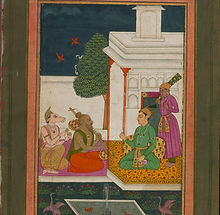Pramana Shruti
Both Bharata and Śārṅagadeva discuss the concept of Pramāṇa Ṥrutī for determining the perceptible value of a Ṥrutī to the human ear.
In the Ṣaḍja Grāma, the fifth degree, Pañcama, encompasses four Ṥrutīs—Kṣiti (Kṣamā), Raktā, Sandīpinī, and Ālāpinī—being naturally situated on the latter. Pa serves as the primary consonant and functions as the Saṁvādī of the tonic. Positioned at a distance of thirteen Ṥrutīs from Ṣaḍja, Pa, and the other consonant, Madhyama, maintains a gap of nine Ṥrutīs from Ṣaḍja.
Examining the Saṁvādī of the second degree, Ṛṣabha, it aligns with Dhaivata, the sixth tone, separated by thirteen Ṥrutīs in both Grāmas. However, when considering the distance of nine Ṥrutīs from the second tone, there is an absence of a note.
Conversely, within the Madhyama Grāma, Pañcama resides on its third Ṥrutī, Sandīpinī, becoming the Saṁvādī of the second degree, Ṛṣabha, positioned at a distance of nine Ṥrutīs from the latter.
Dhaivata, located at a distance of thirteen Ṥrutīs, mirrors its role in the Ṣaḍja Grāma. In both Grāmas, Dhaivata emerges as the Saṁvādī of Ṛṣabha, although in the Madhyama Grāma, it manifests as a note of four Ṥrutīs, having acquired Ālāpinī from Pañcama.
Pañcama, acting as the Saṁvādī of Ṣaḍja in the Ṣaḍja Grāma, undergoes a microtone reduction to serve as the Saṁvādī of Ṛṣabha in the Madhyama Grāma.
Playing both scales simultaneously would reveal the distinctiveness between the two Pañcamas, illustrating the frequency difference known as the Pramāṇa Ṥrutī—an audible microtonal value to the human ear.
INDIAN CLASSICAL MUSIC LESSONS AND ONLINE COURSES
IN MODAL MUSIC, IMPROVISATION AND COMPOSITION
LEARN THE MAIN TECHNIQUES OF INDIAN MUSIC WITH A SIMPLE AND PERSONALIZED METHOD!
My online music lessons are the perfect way to learn to sing, or improve the vocal techniques already acquired, or to start playing your favorite instrument or progress in your musical path through an alternative teaching method to Western teaching.
The goal of my Indian classical music courses is to teach you the basics of this wonderful art form. You will learn about the various Ragas, or modal scales, the Talas or rhythmic cycles, and the vocal and instrumental techniques used for improvisation in Indian classical music.
What makes my approach to teaching indian classical music so distinctive?
My teaching system is obviously unique and different from others and I think that learning music following the traditional Indian approach is the most effective method regardless of genre: pop, jazz, world fusion, electronic, whatever musical style you if you are interested, I guarantee that thanks to the Indian perspective, you will have an edge over all the other musicians.
What will you learn?
During my lessons I use a variety of techniques and exercises to learn to improvise and compose. What you will learn in my Indian classical music courses will be based on the concepts of modal scale and rhythmic cycle, i.e. Raga and Tala. You will also learn vocal and instrumental techniques which, although based on Indian musical theory, also find application in the Western musical system.
Will the course suit you?
My courses are aimed to all musicians of all levels, beginners, intermediate and advanced, offering different study materials and techniques from the usual Western standards. All those who want to learn to play Indian classical music are welcome and no previous knowledge or experience is necessary to get started.
I can not wait to get to know you!
Contact me now! The first lesson is FREE!











%2018th-19th%20centuries%20b.jpg)




